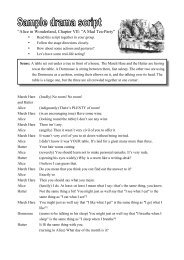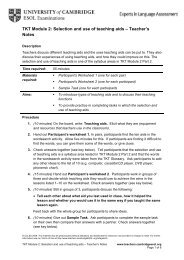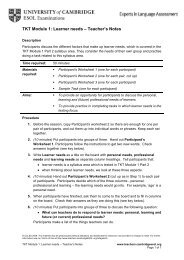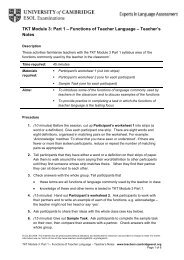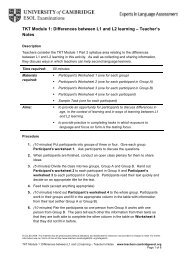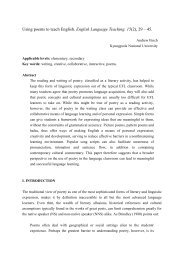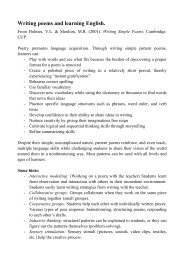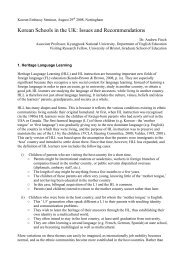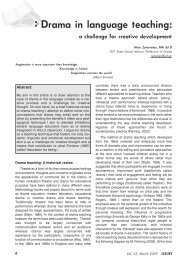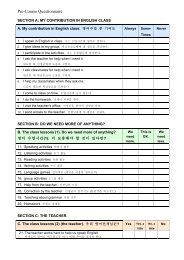Portfolios and Projects: The Understanding Crisis 1 ... - Finchpark
Portfolios and Projects: The Understanding Crisis 1 ... - Finchpark
Portfolios and Projects: The Understanding Crisis 1 ... - Finchpark
Create successful ePaper yourself
Turn your PDF publications into a flip-book with our unique Google optimized e-Paper software.
3. <strong>Projects</strong>While teachers might agree with the analysis of the "underst<strong>and</strong>ing crisis" as outlinedearlier, they will often find themselves unable to act in terms of making radical changes totheir classroom syllabi or teaching method. As Gardner notes, however: "it is up to theingenious educator to exploit constraints as well as to seek to circumvent them" (1993:8).<strong>The</strong> tenet of this paper is that portfolios represent a bridge between formal <strong>and</strong> informallearning situations, with traditional classroom practices on the one h<strong>and</strong>, <strong>and</strong> the projectsyllabus on the other. <strong>The</strong> "ingenious educator" can therefore use portfolios in a traditionalsituation, <strong>and</strong> still promote personal <strong>and</strong> academic awareness. For those who have a greateramount of freedom in what <strong>and</strong> how they teach (<strong>and</strong> we need to consider to what extent ourrestrictions are self-made), portfolios present a means of growth towards the projectsyllabus, itself a means of applying humanistic <strong>and</strong> holistic principles in the classroom.Again (c.f. section 1.2), projects are not simply a new educational fashion. Dewey <strong>and</strong>Kilpatrick, writing in the first half of the 20 th century, laid the theoretical <strong>and</strong> practicalfoundations of learning by <strong>and</strong> through experience, seeing the educational project as a"whole-hearted purposeful activity" (Kilpatrick 1918), taking place in a social environmentupon which it has a significant impact. <strong>The</strong>ir work had considerable influence on <strong>and</strong> wasparalleled by the educational reform movements in Germany after the first World War, <strong>and</strong>Soviet educationalists also took up project learning during the revolutionary <strong>and</strong> postrevolutionaryperiod (cf. Frey 1982). Project learning became a central issue in the 1960s<strong>and</strong> 1970s in the wake of a radical critique of institutionalised schooling (Illich 1970;Graubard 1972; Reimer 1970) <strong>and</strong> became linked with the idea of a more "convivialsociety" (Illich 1970) <strong>and</strong> the democratisation of learning through the introduction of thecomprehensive school. Since then project activities in various fields of education haveabounded (Frey 1982), <strong>and</strong> the term "project" has become blurred, often being used tomean an activity which "is in some kind of opposition to whatever is consideredmainstream educational practice" (Legutke & Thomas 1991:158), with "overgeneralisedconnotations of freedom as opposed to constraint, <strong>and</strong>, unfortunately, fun as opposed toserious <strong>and</strong> responsible work" (Legutke & Thomas 1991:158).Project-based syllabi exemplify process <strong>and</strong> task-based ideas by being "collaborative,avoiding competition, <strong>and</strong> lending themselves to analysis of global goals into subcomponentswhich are then delegated to sub-groups, who take responsibility forcompleting them" (Skehan 1998:273). <strong>The</strong>y have a strong process dimension, but they arealso notable for the product which emerges from the process (e.g. oral presentation, drama,



